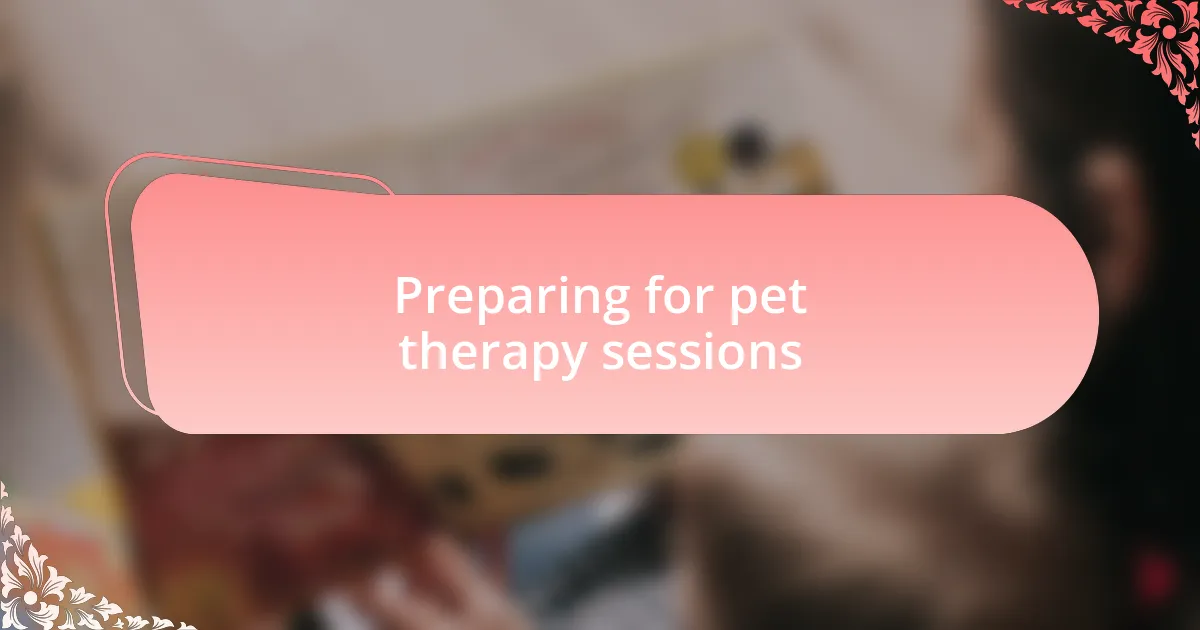Key takeaways:
- Pet therapy utilizes trained animals to provide emotional support, helping children express feelings and build connections.
- Successful pet therapy sessions require proper preparation, including discussing expectations and selecting the right animal for the child’s needs.
- Challenges in pet therapy include allergies, animal temperament, and ensuring consistent participation from families.

Understanding pet therapy
Pet therapy, often referred to as animal-assisted therapy, involves using trained animals to provide comfort and support to individuals facing various challenges. I still remember my first encounter with a therapy dog at a facility for children dealing with anxiety. Watching the joy on their faces as they interacted with the dog was a profound experience that underscored the healing power of animals.
The bond formed between a pet and a child can be incredibly powerful, fostering a sense of safety and trust. During sessions, I observed how many children opened up and shared their feelings while stroking the soft fur of the therapy dog. It made me question—what is it about this connection that seems to transcend words? I believe it’s the unconditional love of animals that often helps children express emotions that might otherwise remain bottled up.
Additionally, research supports the idea that pet therapy can enhance emotional well-being and social skills in children. I recall a young boy who struggled to communicate, yet melted into conversation when his therapy cat curled up next to him. It made me realize how animals can bridge emotional gaps and encourage connection in ways that traditional therapies sometimes cannot. This insight into pet therapy proves that sometimes, all a child needs is a furry friend by their side.

Preparing for pet therapy sessions
Preparing for pet therapy sessions involves a bit of planning and understanding. One aspect that I found useful was discussing expectations with the child before the session. By simply talking about what a therapy session might look like, children often felt more at ease, transforming their curiosity into excitement. How often do we overlook the power of conversation in easing anxiety?
It’s also essential to choose the right animal for the specific needs of the child. In my experience, some children thrived with the playful energy of a dog, while others found comfort in the gentle presence of a cat. I remember a girl who was initially hesitant around animals, but after a session with a calm rabbit, her apprehension transformed into joy. Isn’t it fascinating how the right match can change a child’s entire demeanor?
Finally, preparing the environment plays a crucial role. Creating a welcoming and safe space for the pet can truly enhance the experience. I recall one session where calming music in the background seemed to create an even more soothing atmosphere, allowing the child to relax and engage more openly. This simple addition made me wonder—what other small changes can make a significant impact in such therapeutic settings?

Challenges faced during pet therapy
While pet therapy can be incredibly beneficial, it’s not without its challenges. One significant hurdle I encountered was allergies. I remember a child who was excited about a therapy session with a dog, only to discover during the visit that she was allergic. It was disheartening to see her disappointment. How can we balance the benefits of therapy animals with individual health concerns?
Another challenge involves the temperament of the animal itself. There was an instance when a therapy dog, usually calm and gentle, became overwhelmed by a noisy environment. It was striking to see how the change in atmosphere affected both the child and the animal. This taught me that not all settings work for every pet. How do we ensure that the environment suits the needs of the animal as much as the child’s?
Lastly, securing consistent participation can be tough. I recall one boy who thrived with his therapy cat during our sessions, but his family struggled to commit to a regular schedule. It made me think about how essential consistency is in therapy, not just for children but also for the animals involved. What strategies can we employ to help families prioritize these vital sessions?